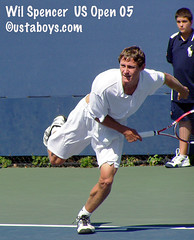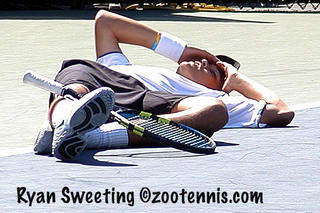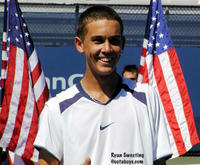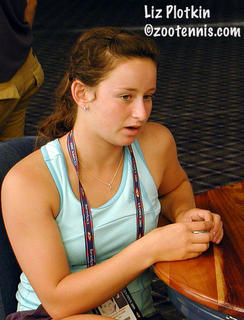Last Words on the Last Slam--
©Colette Lewis 2005--
Jon Wertheim of Sports Illustrated has taken to posting 50 short items following a Grand Slam. Here's his U.S. Open version, with several referring to junior tennis (numbers 34, 40, 46 & 47). When I return from any junior tournament, I try to do some sort of wrap, or in the case of Kalamazoo, a Most Memorable Moments. Here’s the 2005 edition from ustaboys.com.
For the Open, I’m just going to start writing and see what happens. If it’s 12 or 41, I’m not going to get compulsive about it.
1. Cost of hotel room: $168 plus tax, per night. Cost of internet access at hotel: $10 per day. Cost of quart of orange juice at a midtown deli: $4. Opportunity to attend an Andre Agassi press conference: Priceless.

2. It’s always fun to indulge in stupid editor bashing, but this is pathetic/hilarious. A reporter claimed that on Thursday, an editor asked him if James Blake was an American.
3. The USTA PR department actually distributes a list of celebrities in attendance for the final weekend. Among the Robin Williams, Lance Armstrong, Dustin Hoffman and Christie Brinkley spottings, was one they didn’t catch. (And whose job description contains this requirement—must recognize stars on sight, sports familiarity helpful but not necessary?) On the middle weekend, I saw Dave Barry, whom I consider the best humorist writing today (or not writing, as he is on sabbatical now) with his daughter Sophie. It’s not as if he’s famous for being a tennis fan, but his wife, Michelle Kaufman of the Miami Herald, is a sportswriter, and she was covering the Open all week.
4. One phrase I never want to hear again from a chair umpire, when asked by a player if a serve caught the center line of the T is, “I don’t know.” Yes or no are the two options when you are paid for your judgments.
5. ITF seeding is a joke, especially in doubles. I could go on a thousand word rant, but suffice it to say that seeding half of the winning French Open doubles team number one, and the Wimbledon champions not at all showed poor judgment. The former lost the first match they played, the latter got to the semifinals. The second seeded team, who did reach the finals, was playing in their second tournament together. If there is any logic to the numbers, I can’t find it.
6. And while I’m complaining, why aren’t juniors allowed to schedule practice courts? When over 35s and over 45s can? I heard several parents praise the Segusos, both of whom were playing events, for assisting juniors (in addition to their son Holden) in their search for a place to practice. Maybe that’s a policy that has outlived its usefulness. And while they are overhauling, how about letting the juniors use their credentials to get in the first week? They could have watched Scoville Jenkins, a year removed from them, or Andy Murray, still their age, win inspirational five set matches. If you are one of the 128 players in the WORLD to get into the U.S. Junior Open, perhaps the perk of a free pass to the grounds of the National Tennis Center isn’t going to break the USTA.
7. Speaking of juniors practicing, it was good to see Jim Courier out on the court playing a set with Alex Clayton one morning, and another with Holden Seguso the following afternoon. And Jamie Hunt got an opportunity to hit with Robby Ginepri on Friday. No, the match didn’t go five sets. Ginepri limited it to one, which he took 6-3.
8. The weather exceeded perfection, making the venue extra cheerful, but the National Tennis Center gets prettier every year. The new fountains are stunning, and complain all you want about the late afternoon matches (as many a journalist on deadline did), the quality of the light during that time produces golden photographs and memories.
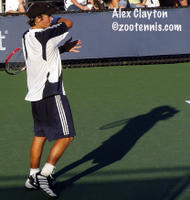
9. It was great to catch up with press colleagues from last year—Whit Sheppard, Gavin Versi, Allen St. John—all of whom encouraged me then and throughout the year in my quest for a freelance career. And sitting next to Peter Bodo was a lesson in civility and hard work. A simple question I heard him ask someone who had told him an interesting tidbit—“can I print that?”—strikes me as the perfect metaphor for his approach. Polite and politic, and also willing to take a stand. A potent combination.
10. Although I saw Scott Oudsema in person, playing his second round main draw doubles match, there was no sign of him in conjunction with the Ralph Lauren Polo sponsorship. I even took the hike from media center to onsite store to see if I’d just missed the big splash somehow. The store was packed with fans, but even there, no photographic evidence of his modelling career.
11. No one was happier than Mark Bey when the Bryan twins finally broke through and won a Grand Slam doubles title after losing in the three previous finals this year. Bey, who coaches promising junior Dennis Nevolo at his Libertyville Illinois club, has been working with the Bryans for many years, a connection that he traces to their days in juniors. Maybe doubles can’t fill a stadium the size of Ashe, but there must be a way to maintain the game’s integrity, pay its practitioners adequately and promote it enough to fill Armstrong or the Grandstand, at least. 
12. John Roddick’s academy (Roddick-Moros International Tennis Academy) has reached that vaunted Tipping Point. With Nate Schnugg, Tyler Hochwalt, Kellen Damico, Andy Magee and Jamie Hunt traveling and working with John, (I’m sure there are others I’m missing) and Justin Kronauge and Ryan Sweeting visiting for short-term instruction, the vibe is beginning to rival that of Saddlebrook or Bolliettieri. It’s still small enough to allow John to actually coach and let me say right now that I’m in awe of his ability to travel with so many teenage boys (and even an occasional girl) and still maintain his sanity. And there’s nobody I’d rather watch a match with, (well, maybe Mike Sell).
13. The Tennis Channel people actually know and love tennis. What a relief it was to learn that. Why would I think otherwise? Well, let’s just say there are a few folks in the media center who are there because it’s in New York and it’s considered a major sporting event. Now if The Tennis Channel could only get Charter Communications onboard….
14. Could somebody explain to me why the girls and boys singles finals have to be played simultaneously? And why the portable radar gun can’t be installed for the finals?
15. Initially skeptical, I admit to being won over by the blue courts. Much easier on the eyes than dusty clay or chewed up grass. But then, so was the green. I’m just a fan of hardcourts, when it comes right down to it.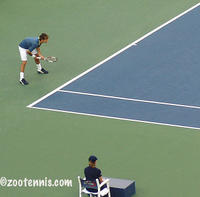
16. I don’t envy Pat McEnroe’s choice between Robby Ginepri and James Blake for the second singles spot in next weekend’s Davis Cup tie on clay in Belgium, but I do think he made great selections for the hitting partners. It’s Alex Clayton’s best surface, and Sam Querrey went deeper in the draw than any other American junior at the French this spring. Exposure to the team and the surface will be invaluable to them.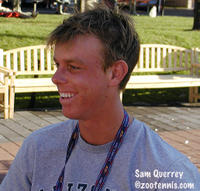
There, that turns out to be a recognizable tennis number, 16, the number of seeds in a Slam in the good old days. But I can’t put the U.S. Open to rest without thanking, inadequately, my husband Paul, who took most of the photographs gracing this blog the past ten days. There isn’t a kinder or more accommodating man on the planet, or a more resourceful one either. It’s twice the fun when he’s there to share it.



